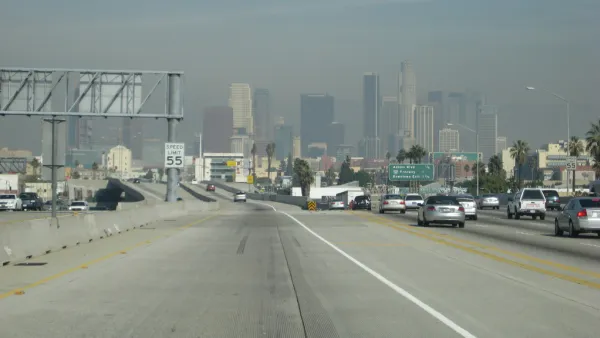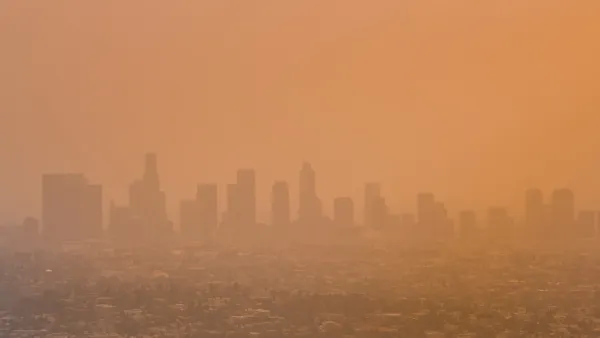A new study by NOAA scientists and colleagues shows a stunning reduction in vehicle-related air pollutants in the Los Angeles basin over the past several decades. Despite the gains, unhealthy air remains.
The recent paper, published in the Journal of Geophysical Research, shows a dramatic 98 percent drop in air pollution from motor vehicles since the 1960s, despite a threefold increase in the use of gasoline and diesel fuel over the same period. The chemicals tracked by the researchers, called volatile organic compounds (VOCs), are primarily emitted from the tailpipes of vehicles, and "are a key
ingredient in the formation of ground-level ozone," writes the National Oceanic and Atmospheric Administration.
"The magnitude of the drop in VOC levels was surprising, even to
researchers who expected some kind of decrease resulting from
California's longtime efforts to control vehicle pollution."
"Even on the most polluted day during a research mission in
2010, we measured half the VOCs we had seen just eight years earlier," said Carsten Warneke, Ph.D., a NOAA-funded scientist with the Cooperative Institute for Research in Environmental Sciences (CIRES) at the University of Colorado Boulder. "The difference was amazing."
Despite the improvements in vehicle emissions, attributed to "requirements for catalytic converters, use of reformulated fuels less
prone to evaporate, and improved engine efficiency of new vehicles," overall ozone levels in L.A. have not fallen as steeply. "Ozone pollution in the
Los Angeles Basin has decreased since the 1960s, but levels still don't
meet ozone standards set by the Environmental Protection Agency."
FULL STORY: NOAA, partners find 50-year decline in some Los Angeles vehicle-related pollutants

National Parks Layoffs Will Cause Communities to Lose Billions
Thousands of essential park workers were laid off this week, just before the busy spring break season.

Retro-silient?: America’s First “Eco-burb,” The Woodlands Turns 50
A master-planned community north of Houston offers lessons on green infrastructure and resilient design, but falls short of its founder’s lofty affordability and walkability goals.

Delivering for America Plan Will Downgrade Mail Service in at Least 49.5 Percent of Zip Codes
Republican and Democrat lawmakers criticize the plan for its disproportionate negative impact on rural communities.

Test News Post 1
This is a summary

Test News Headline 46
Test for the image on the front page.

Balancing Bombs and Butterflies: How the National Guard Protects a Rare Species
The National Guard at Fort Indiantown Gap uses GIS technology and land management strategies to balance military training with conservation efforts, ensuring the survival of the rare eastern regal fritillary butterfly.
Urban Design for Planners 1: Software Tools
This six-course series explores essential urban design concepts using open source software and equips planners with the tools they need to participate fully in the urban design process.
Planning for Universal Design
Learn the tools for implementing Universal Design in planning regulations.
EMC Planning Group, Inc.
Planetizen
Planetizen
Mpact (formerly Rail~Volution)
Great Falls Development Authority, Inc.
HUDs Office of Policy Development and Research
NYU Wagner Graduate School of Public Service




























